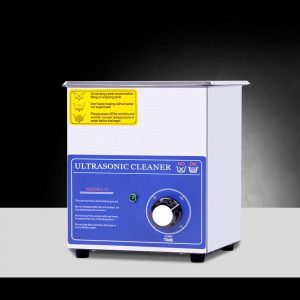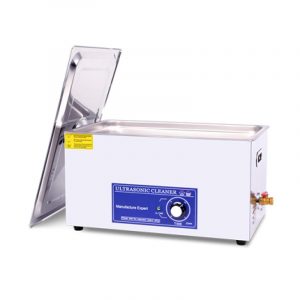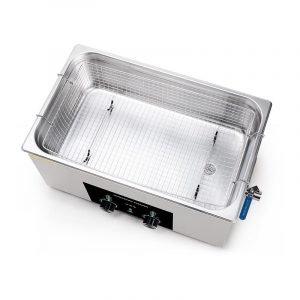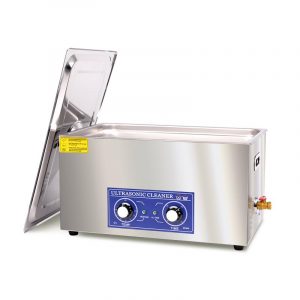Ultrasonic cleaning machine structure, principle, classification, application and selection of common problems
Laboratory ultrasonic cleaning machine is a kind of equipment that uses ultrasonic technology to clean. It uses the principle that tiny bubbles generated by high-frequency acoustic vibration explode in a liquid to clean surfaces and tiny pores in an effective and non-contact way.
Structure of components
Cleaning tank: used to hold objects to be cleaned and cleaning liquid. It is usually made of corrosion-resistant materials such as stainless steel and has a certain size and volume.
Ultrasonic generator: A device that produces high-frequency acoustic vibration. It converts electrical energy into mechanical vibration, which is transmitted to the cleaning fluid in the cleaning tank through sensors.
Ultrasonic transducer: A device that converts electrical energy into acoustic vibration. It converts the high-frequency electrical energy generated by the ultrasonic generator into acoustic energy and transmits it to the cleaning liquid in the cleaning tank.
Control panel: used to set and control the parameters of the cleaning machine, such as cleaning time, ultrasonic power, etc. Through the control panel, users can adjust the cleaning process according to their needs.

Ultrasonic cleaning machine structure, principle, classification, application and selection of common problems
How it works
When using the laboratory ultrasonic cleaning machine, the object to be cleaned is first placed in the cleaning tank, and then the right amount of cleaning liquid is added. After starting the cleaning machine, the ultrasonic generator will produce high-frequency acoustic vibration, which is transmitted to the surface of the object and small pores through the liquid. These acoustic vibrations form tiny bubbles in the liquid, which produce a violent impact as they expand and contract, thus stripping dirt and pollutants from the surface and pores of the object. The chemicals in the cleaning solution can also help remove dirt.

Scope of application
Laboratory ultrasonic cleaning machine is widely used in laboratory, medical, electronic, optical and other fields, used to clean all kinds of experimental instruments, glassware, metal parts, electronic components, etc. It has the characteristics of effective, fast, lossless and pollutionless, and can thoroughly clean the surface of objects and fine pores, and improve the efficiency and quality in the experiment and production process.
Type of equipment
Laboratory ultrasonic cleaning machines can be classified based on their functions and application areas. Here are some common types:
Tabletop ultrasonic cleaning machine: This type of cleaning machine is suitable for small laboratories or occasions where smaller objects need to be cleaned. They usually have a smaller cleaning tank capacity and power and are suitable for handling small batches of experimental utensils and samples.
Industrial ultrasonic cleaning machine: This type of cleaning machine is suitable for industrial production environment, handling large quantities of object cleaning. They typically have a large cleaning tank capacity and high power, and are able to handle objects of larger size and weight.
Medical ultrasonic cleaner: This type of cleaner is specially designed for use in the medical industry for cleaning medical instruments, utensils, and equipment. They usually have special cleaning procedures and functions to ensure the thorough removal of contaminants and microorganisms.
Special materials cleaning machines: Some ultrasonic cleaning machines are specially used to deal with special materials, such as glass, ceramics, optical devices, etc. They have special cleaning fluids and parameter Settings to avoid damage to these materials.
Automated ultrasonic cleaning system: This type of cleaning machine is equipped with an automated system that enables an automated cleaning process. They usually have automatic feeding and blanking functions, which can improve production efficiency and reduce manpower input.

Ultrasonic cleaning machine structure, principle, classification, application and selection of common problems
These types of ultrasonic cleaners may vary in size, power, functionality, and application areas. According to the specific needs, you can choose the suitable type and specification of ultrasonic cleaning machine. There are some differences in the application of ultrasonic cleaning machines with different power. The following are some common application examples of ultrasonic cleaning machines with different powers:
Low power washer (typically tens to hundreds of watts) :
Laboratory application: used for cleaning laboratory utensils, glass ware, small reagent bottles, etc.
Electronic industry: suitable for cleaning small electronic components, circuit boards and other small parts.
Jewelry and eyewear industry: used for cleaning jewelry, eyewear frames and other small items.
Medium power cleaners (typically hundreds of watts to a few kilowatts) :
Industrial application: used for cleaning machine parts, metal parts, molds, etc.
Automotive industry: suitable for cleaning engine parts, nozzles, oil nozzles, etc.
Medical industry: used for cleaning medical instruments, surgical instruments, dental instruments, etc.
High power cleaning machine (generally a few kilowatts to tens of kilowatts) :
Industrial application: suitable for cleaning large mechanical parts, steel products, pipelines, etc.
Aerospace industry: used for cleaning aero-engine parts, aviation parts and other large objects.
Manufacturing: suitable for cleaning large workpieces, castings, welding parts, etc.
Ultrasonic cleaning machine structure, principle, classification, application and selection of common problems
Selection considerations
The specific power should be determined according to the size, shape, material of the cleaning object and the degree of pollution to be cleaned. The higher the power, the better the cleaning effect of the cleaning machine is usually, but the tolerance of the object and the choice of cleaning fluid also need to be taken into account. Therefore, when selecting ultrasonic cleaning machine, the appropriate power range should be selected according to the specific application requirements and object characteristics. The following key factors can be considered when selecting a suitable ultrasonic cleaning machine:
Cleaning objects: It is first necessary to determine the type, size and material of objects to be cleaned. Different objects may have different requirements on the power and capacity of the cleaning machine. In the case of large objects or large batches to be cleaned, it may be necessary to choose a cleaner with higher power and larger capacity.
Cleaning requirements: Determine the cleaning requirements and standards. Different application scenarios may have different requirements on cleaning effect, cleaning speed and cleaning degree. For example, the medical industry requires a high degree of thoroughness in cleaning instruments, while laboratories may pay more attention to the degree of purification of cleaning utensils. According to the requirements, select the appropriate power and function.
Cleaning fluid: choosing the right cleaning fluid is very important to the cleaning effect. Different cleaning fluids may have different requirements for ultrasonic cleaning machines. For example, some special materials may require the use of specific cleaning fluids, and some application scenarios may require high temperature or special chemical composition of cleaning fluids. Make sure the washer is suitable for the cleaning fluid required.
Budget and available space: Consider the budget and available space. The price and size of ultrasonic cleaning machines vary by model and function. Depending on the budget and available lab or workspace space, choose the appropriate model.
User friendliness: Consider the ease of use and ease of operation of the cleaning machine. Choosing a cleaning machine with easy setup and control, as well as cleaning process monitoring and automation functions, can improve work efficiency and convenience.

Q&A
Here are some common questions and answers when selecting and using a laboratory ultrasonic cleaning machine:
How to choose the power of the cleaning machine? The power selection should be determined according to the size, shape, material of the cleaning object and the degree of pollution to be cleaned. In the case of large objects or large batches to be cleaned, it may be necessary to choose a cleaner with higher power. In general, depending on object size, low power (tens of watts to hundreds of watts) is suitable for small objects, medium power (hundreds of watts to several kilowatts) is suitable for medium size objects, and high power (several kilowatts to tens of kilowatts) is suitable for large objects.
How to choose cleaning fluid? The choice of cleaning fluid should be determined according to the material of the cleaning object and the type of pollution. In general, a specially designed ultrasonic cleaning fluid is used or an appropriate cleaning agent is selected according to the cleaning requirements. Special materials or specific application areas may require the use of specific cleaning fluids. Pay attention to the composition and use method of cleaning liquid to ensure safety and cleaning effect.
What should be paid attention to in the maintenance and maintenance of the cleaning machine? Regular cleaning and maintenance of a cleaning machine is key to maintaining its performance and longevity. The tank and drainage system should be cleaned after the cleaning machine is used to prevent the accumulation of cleaning liquid residue and pollutants. Regularly check ultrasonic transducers and other critical components for proper functioning and maintain them according to the manufacturer’s instructions. Follow safe operating procedures to avoid damage to the cleaning tank and ultrasonic generator.
Ultrasonic cleaning machine structure, principle, classification, application and selection of common problems
Is ultrasonic cleaning suitable for all objects? Ultrasonic cleaning is suitable for many different types of objects including metal, glass, plastic, ceramics, etc. However, certain materials or objects may be more sensitive to ultrasonic vibration, so the proper cleaning parameters and cleaning fluid need to be carefully selected. For special materials or sensitive objects, it is recommended that they be tested before use to ensure that they withstand the ultrasonic cleaning process.
How to verify the effect of ultrasonic cleaning? After the cleaning is completed, the cleaning effect can be verified by naked eye observation, microscope or other detection methods. Check that the surface of the object is clean and free of residues or contaminants. Sometimes chemical indicators or test instruments can be used to verify the cleaning effect, such as surface tension tester, residual contamination test, etc.

